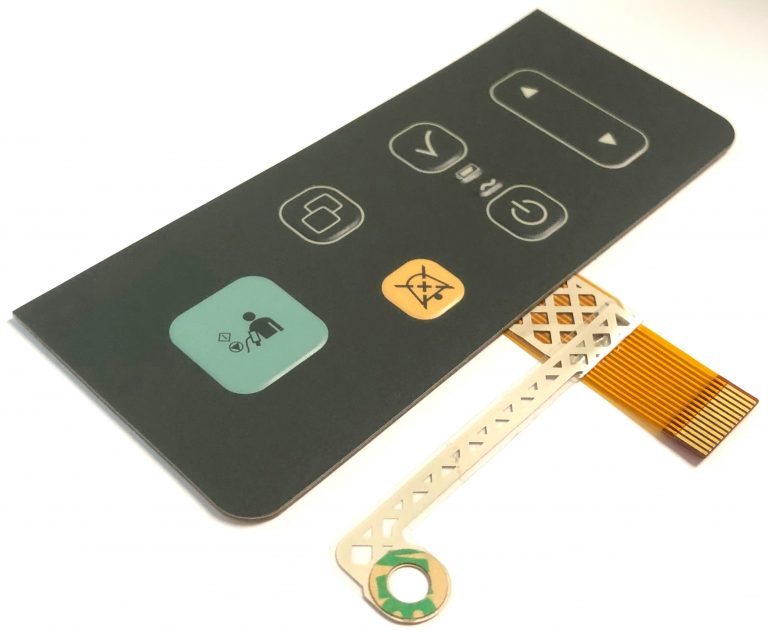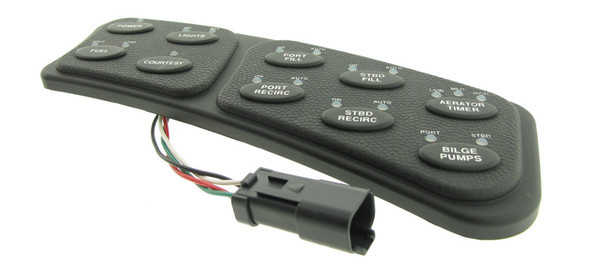The Production Process Behind Membrane Layer Switch: What You Required to Know
The manufacturing procedure behind membrane switches over combines cautious layout, material option, and high quality control. It starts with comprehending the intricacies of membrane button layout and advances through different phases, including product choices and printing strategies. Each phase plays a crucial function in making certain performance and longevity. The complexities of layer building and construction and the rigorous screening standards might expose insights that are not promptly apparent. What lies past these fundamental aspects?
Understanding Membrane Layer Switch Style
Although membrane layer switches may show up straightforward in the beginning look, their layout involves elaborate factors to consider that guarantee performance and durability. The design process begins with a complete understanding of user needs, including the user interface's intended application and environmental elements. Ergonomics is a crucial element, as the design must facilitate convenience of use while making certain that responsive feedback satisfies customer expectations.Moreover, the layering of elements, such as visuals overlays, adhesive layers, and conductive traces, have to be precisely crafted. membrane switch. This split configuration not only affects the button's responsiveness yet additionally influences its durability. Attention is provided to the sealing strategies used to secure versus dampness and dust, which can compromise efficiency. In addition, style factors to consider extend to visual appeals, where color plans and visual clarity enhance user experience. Ultimately, the design of membrane layer switches over balances performance, individual experience, and longevity, making sure that they meet the demands of numerous applications properly
Materials Used in Membrane Switch Over Manufacturing
When selecting materials for membrane layer switch manufacturing, it is essential to contemplate both efficiency and toughness. The main products consist of polyester and polycarbonate films, which provide flexibility and stamina. These movies are typically coated with sticky to guarantee correct bonding to substratums. Conductive inks, usually composed of silver or carbon, are vital for developing electric connections within the button, enabling dependable operation.Additionally, a protective layer, such as a difficult coat, is often used to enhance scrape resistance and long life. The selection of backing product, such as acrylic or foam, can significantly impact the button's responsive feeling and overall user experience. Various environmental elements, consisting of temperature level and humidity, ought to assist product selection to guarantee peak efficiency in certain applications. Inevitably, the right combination of materials adds to the membrane switch's functionality and life expectancy, making notified options necessary for manufacturers.
The Printing Refine: Creating Graphics and Text
The printing process in membrane layer button production plays a considerable function in creating top notch graphics and text. Numerous graphic design strategies are employed to ensure visual charm and functionality, while careful ink option approaches are necessary for durability and efficiency. Comprehending these aspects is basic for accomplishing best cause membrane button style.
Graphic Design Techniques
Graphic layout methods play a vital duty in the printing procedure of membrane buttons, as they specify how graphics and message will ultimately show up on the final item. Reliable graphic layout includes the calculated use of fonts, layouts, and colors to enhance readability and aesthetic charm. Developers typically utilize vector graphics for scalability, guaranteeing that photos stay sharp at various dimensions. Additionally, focus to contrast and alignment is essential, as it influences individual interaction and visual top quality. The incorporation of branding aspects, such as logo designs, need to be taken care of with like preserve brand integrity. In general, thoughtful visuals layout strategies add significantly to the capability and good looks of membrane switches, affecting user experience and item performance.
Ink Selection Approaches
Selecting the suitable ink is necessary for attaining the desired aesthetic high quality and toughness in membrane layer switch production. Different ink types are used, consisting of solvent-based, water-based, and UV-curable inks. Each kind provides distinct features, such as adhesion, resistance, and adaptability to ecological factors. Solvent-based inks are often favored for their durability and vibrant shades, while water-based inks are a lot more ecologically pleasant yet might have constraints in attachment. UV-curable inks give rapid treating and durable efficiency. In addition, shade matching techniques assure that the selected inks line up with layout specifications. Inevitably, the choice of ink have to take into consideration variables such as application method, substrate compatibility, and end-use requirements to achieve superior cause membrane switch graphics and message.
Layer Building and Assembly

Product Selection Refine
A cautious selection of products is important in the manufacturing process of membrane layer buttons, as it straight affects functionality and longevity. The key products made use of consist of polyester, polycarbonate, and various conductive inks. Polyester is frequently favored for its excellent resistance to chemicals and abrasion, making it appropriate for rough environments. Polycarbonate, on the other hand, gives remarkable clearness and impact resistance, which is advantageous for applications needing exposure and toughness. Conductive inks, typically composed of silver or carbon, are crucial for developing dependable electrical pathways. Furthermore, the option of adhesive materials impacts the overall integrity of the switch - membrane switch. Evaluating elements such as environmental exposure, tactile comments, and aesthetic demands guides suppliers in picking the very best materials for their particular applications
Layer Bond Techniques
Adhering layers in membrane switch building and construction is an important procedure that guarantees capability and longevity. Various bond techniques are used to secure suitable bonding between layers, which usually consist of using adhesives, heat, and pressure. Pressure-sensitive adhesives (PSAs) are frequently made use of for their convenience of application and instant bonding capabilities. Additionally, thermal bonding strategies can be used, where heat is made use of to turn on adhesive homes, securing a solid bond. The choice of attachment approach mainly relies on the products included and the particular application requirements of the membrane layer switch. Correct positioning and consistent application of adhesives are important to prevent issues, protecting the switch operates properly throughout its desired life-span.
Top Quality Control Steps
Assuring quality assurance throughout the layer construction and setting up of membrane layer buttons is vital for keeping performance and reliability. This procedure commonly involves a number of critical procedures, including complete evaluations at each stage of production. Suppliers use advanced testing techniques, such as peel examinations and bond assessments, to confirm the stability of layer bonds. In addition, visual inspections are performed to identify any issues in printing or material disparities. Environmental problems, such as temperature and moisture, are thoroughly monitored to assure suitable treating and attachment. Additionally, normal calibration of equipment aids keep precise manufacturing standards. By carrying out these quality assurance measures, makers can considerably reduce the threat of product failing, assuring that the last membrane layer switches fulfill the required specs and client assumptions.
Examining and Top Quality Control Steps

Innovations in Membrane Change Modern Technology
As improvements in technology remain to develop, membrane layer buttons are profiting from ingenious growths that enhance their performance and individual experience. One noteworthy development is the assimilation of capacitive touch modern technology, which permits more intuitive and responsive interface. This change not only enhances visual appeals however also reduces mechanical wear and tear, prolonging the lifespan of the switches.Additionally, developments in visuals overlay products have actually led to enhanced toughness and resistance to ecological aspects such as dampness and UV light. These materials currently supply improved clearness and illumination, further boosting the aesthetic appeal.Furthermore, the consolidation of clever innovation is changing membrane layer switches over into interactive control panels, enabling connection with IoT devices. This connection promotes a seamless customer experience, leading the way for applications have a peek at this website in different sectors, from healthcare to customer electronic devices. Jointly, these innovations placement membrane changes as crucial elements in modern device style.
Regularly Asked Concerns
For how long Does the Membrane Layer Change Manufacturing Process Take?
The duration of the membrane switch manufacturing procedure can differ considerably. Elements such as complexity, products utilized, and manufacturing volume impact timelines, with typical manufacturing varying from a couple of days to numerous weeks for completion.
What Are the Typical Applications for Membrane Buttons?
Membrane layer buttons are generally made use of in different sectors, including vehicle controls, house devices, medical gadgets, and consumer electronic devices (membrane switch). Their convenience and toughness make them excellent for applications calling for easy to use user interfaces and reputable efficiency in varied environments
Can Membrane Switches Over Be Custom-made for Specific Requirements?

What Is the Life-span of a Typical Membrane Layer Switch?
The life expectancy of a regular membrane button differs, yet normally, it varies from 1 to 5 million cycles. Variables such as usage, environment, and material top quality substantially influence toughness and total performance gradually.

Are Membrane Layer Changes Ecologically Friendly?
The environmental kindness of membrane layer switches over differs. Some products made use of may not be recyclable, while others can be environmentally friendly. The overall influence relies on producing techniques and products, demanding cautious consideration throughout choice and disposal. The production procedure behind membrane switches combines mindful style, product choice, and quality control. It starts with comprehending the details of membrane button design and progresses with numerous stages, consisting of product choices and printing strategies. When selecting products for membrane button production, it blog here is vital to contemplate both performance and toughness. A careful selection of products is essential in the production procedure of membrane layer switches, as it straight affects performance and durability. The selection of attachment method largely depends on the materials involved and the particular application demands of the membrane switch.